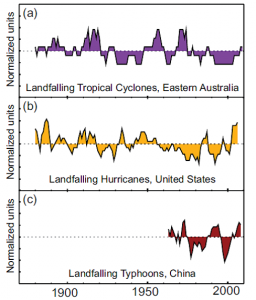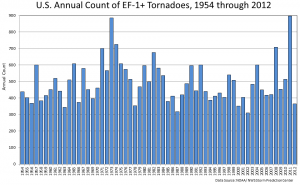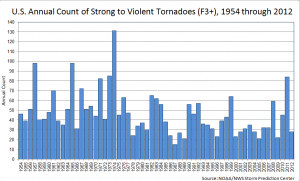There is broad (though not unanimous) agreement, even among skeptic scientists, that the earth has warmed moderately over the past 60 years and that some portion of that warming can be attributed to anthropogenic carbon dioxide emissions. However, despite the hoopla surrounding the recent report on the economic impacts of global warming from the U.N.’s Intergovernmental Panel on Climate Change (IPCC), there is no consensus that temperatures are increasing at an accelerating rate or that we are headed to a climate catastrophe.
In fact, far from increasing at an accelerating rate, the best measures of world average temperatures indicate that there has been no significant warming for the past 15 years—something that the IPCC’s climate models are unable to explain.
Perhaps frustrated by the climate’s unwillingness to follow the global-warming script, the hard-core advocates for costly, energy-killing programs now point to every weather event as the wages of carbon-emitting sins. However, the numbers tell a different story: Upward trends for extreme weather events just aren’t there.
Myth #1: Hurricanes are becoming more frequent.
Even the IPCC notes there is no trend over the past 100 years. Here’s what the IPCC says in its latest science report:
Current data sets indicate no significant observed trends in global tropical cyclone frequency over the past century and it remains uncertain whether any reported long-term increases in tropical cyclone frequency are robust, after accounting for past changes in observing capabilities.… No robust trends in annual numbers of tropical storms, hurricanes and major hurricanes counts have been identified over the past 100 years in the North Atlantic basin. [Emphasis added.]
Some people will make a big deal about an increase in North Atlantic hurricanes since the 1970s. As the IPCC chart below (Panel b) shows, the 1970s had the lowest frequency of landfalling hurricanes in the past 100 years.
Source: IPCC AR5
Hurricane Sandy seems to be an argument in a class by itself. It should be noted that Sandy became an extratropical cyclone before it made landfall. Here is what the IPCC says about historical trends in extratropical cyclones: “In summary, confidence in large scale changes in the intensity of extreme extratropical cyclones since 1900 is low.”
Also, data from the National Oceanic and Atmospheric Administration (NOAA) covering the years 1851—2004 show that hurricanes made a direct hit on New York State about every 13 years on average. Over the period, there were a total of 12 hurricanes that made landfall along the New York coastline. Five of them were major hurricanes.
Myth #2: Tornadoes are becoming more common.
The experts at the National Climatic Data Center (part of NOAA) say:
To better understand the variability and trend in tornado frequency in the United States, the total number of EF-1 and stronger, as well as strong to violent tornadoes (EF-3 to EF-5 category on the Enhanced Fujita scale) can be analyzed. These tornadoes would have likely been reported even during the decades before Doppler radar use became widespread and practices resulted in increasing tornado reports. The bar charts below indicate there has been little trend in the frequency of the stronger tornadoes over the past 55 years. [Emphasis added.]
That is, once we account for the apparent increase in tornado counts that are due to much improved technology for identifying them, tornadoes occur no more frequently now than in the past.
Even more striking is the history of F3 and stronger tornadoes (shown below), which were even less likely to be missed before Doppler radar. That trend is actually down compared to the 1955–1975 period:
Myth #3: Droughts are becoming more frequent and more severe.
In the recent science report, even the IPCC finds little evidence to support the myth regarding droughts, and it backs off from its support in a previous report. Here is a quote from the AR5:
In summary, the current assessment concludes that there is not enough evidence at present to suggest more than low confidence in a global-scale observed trend in drought or dryness (lack of rainfall) since the middle of the 20th century, owing to lack of direct observations, geographical inconsistencies in the trends, and dependencies of inferred trends on the index choice. Based on updated studies, AR4 conclusions regarding global increasing trends in drought since the 1970s were probably overstated.
Myth #4: Floods are becoming more frequent and severe.
The IPCC’s science report states, “In summary, there continues to be a lack of evidence and thus low confidence regarding the sign of trend in the magnitude and/or frequency of floods on a global scale.”
For the U.S., the story is the same. Some places will always be drier and some wetter in comparison to an earlier period. However, for the U.S. overall, there has been no trend. The chart below of the Palmer Hydraulic Drought Index (PHDI) shows no trend for increasing droughts (represented by bars with negative values). From 1930 to 1941, the PHDI was consistently negative and set annual records that have not been matched.
Source: National Climatic Data Center
Myth #5: Global warming caused the polar vortex that led to the extreme cold and snow in the eastern half of North America in the winter of 2013–2014.
A letter in Science magazine by prominent non-skeptic scientists had this to say about global warming leading to polar vortexes: “It’s an interesting idea, but alternative observational analyses and simulations with climate models have not confirmed the hypothesis, and we do not view the theoretical arguments underlying it as compelling.”
After looking at evidence of jet-stream variability (the supposed link between a warming arctic and polar vortexes), authors of a paper in the Quarterly Journal of the Royal Meteorological Society conclude, “When viewed in this longer term context, the variations of recent decades do not appear unusual and recent values of jet latitude and speed are not unprecedented in the historical record.”
Climate blogger Anthony Watts summed it up nicely: “Finally a real scientific consensus—everyone agrees that the recent displaced polar vortex wasn’t caused by global warming.”






























